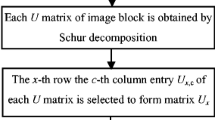Abstract
This paper proposes a new algorithm of blind color image watermarking based on LU decomposition. Because of the first column the second row element and the first column the third row element of the lower triangular matrix, which obtained by LU decomposition, have higher similarity, and the color image watermark can be embedded into these elements by slightly modifying rules, which can enhance the watermark invisibility. In addition, Arnold transform is applied to improve the watermark security and the Hash pseudo-random number algorithm based on MD5 is used to improve the watermark robustness. In extraction process, the watermark embedding strength and private key are needed to extract watermark information from the attacked host image with blind manner. Experiment results reveal that the proposed method outperforms other related methods in the aspects of the invisibility, robustness, embedding payload and computational complexity.









Similar content being viewed by others
References
Bhatnagar, G., & Wu, Q. M. J. (2013). Biometrics inspired watermarking based on a fractional dual tree complex wavelet transform. Future Generation Computer Systems, 29(1), 182–195.
Chen, W., Quan, C., & Tay, C. J. (2009). Optical color image encryption based on Arnold transform and interference method. Optics Communications, 282(18), 3680–3685.
Chen, B., Shu, H., Coatrieux, G., Chen, G., Sun, X., & Coatrieux, J. (2015). Color image analysis by quaternion-type moments. Journal of Mathematical Imaging and Vision, 51(1), 124–144.
Golea, N. E. H., Seghir, R., & Benzid, R. (2010). A bind RGB color image watermarking based on singular value decomposition. In IEEE/ACS international conference on computer systems and applications (AICCSA), 2010, pp. 1–5.
Guo, J., & Prasetyo, H. (2014). Security analyses of the watermarking scheme based on redundant discrete wavelet transform and singular value decomposition. International Journal of Electronics and Communications, 68, 816–834.
Jane, O., & Elbasi, E. (2014). A new approach of nonblind watermarking methods based on DWT and SVD via LU decomposition. Turkish Journal of Electrical Engineering & Computer Sciences, 22(5), 1354–1366.
Jia, S. (2014). A novel blind color images watermarking based on SVD. Optik-International Journal for Light and Electron Optics, 125(12), 2868–2874.
Lai, C. C. (2011). An improved SVD-based watermarking scheme using human visual characteristics. Optics Communications, 284(4), 938–944.
Li, J., Li, X., Yang, B., & Sun, X. (2015). Segmentation-based image copy-move forgery detection scheme. IEEE Transactions on Information Forensics and Security, 10(3), 507–518.
Niu, S. Z., Niu, X. X., & Yang, Y. X. (2004). Digital watermarking algorithm based on LU decomposition. Journal of Electronics & Information Technology, 26(10), 1620–1625.
Rivest, R. L. (1992). The MD5 message digest algorithm, Internet RFC 1321.
Shao, Z., Duan, Y., Coatrieux, G., Wu, J., Meng, J., & Shu, H. (2015). Combining double random phase encoding for color image watermarking in quaternion gyrator domain. Optics Communications, 343, 56–65.
Song, W., Hou, J., Li, Z., & Huang, L. (2011). Chaotic system and QR factorization based robust digital image watermarking algorithm. Journal of Central South University of Technology, 18(1), 116–124.
Su, Q., Niu, Y., Liu, X., & Zhu, Y. (2012). Embedding color watermarks in color images based on Schur decomposition. Optics Communications, 285(7), 1792–1802.
Su, Q., Niu, Y., Wang, G., Jia, S., & Yue, J. (2014a). Color image blind watermarking scheme based on QR decomposition. Signal Processing, 94(1), 219–235.
Su, Q., Niu, Y., Zou, H., Zhao, Y., & Yao, T. (2014b). A blind double color image watermarking algorithm based on QR decomposition. Multimedia Tools and Applications, 72(1), 987–1009.
University of Granada, Computer Vision Group. CVG-UGR Image Database. (2012). http://decsai.ugr.es/cvg/dbimagenes/c512.php20.
Vahedi, E., Zoroofi, R. A., & Shiva, M. (2012). Toward a new wavelet-based watermarking approach for color images using bio-inspired optimization principles. Digital Signal Processing, 22(1), 153–162.
Wang, S., Zhao, W., & Wang, Z. (2008). A gray scale watermarking algorithm based on LU factorization. In International symposiums on information processing, pp. 598–602.
Wang, Z., Bovik, A. C., Sheikh, H. R., & Simoncelli, E. P. (2004). Image quality assessment: From error visibility to structural similarity. IEEE Transactions on Image Processing, 13(4), 600–612.
Wang, X., Wang, C., Yang, H., & Niu, P. (2013). A robust blind color image watermarking in quaternion Fourier transform domain. Journal of Systems and Software, 86(2), 255–277.
Yashar, N., & Saied, H. K. (2010). Fast watermarking based on QR decomposition in Wavelet domain. In Sixth international conference on intelligent information hiding and multimedia signal processing, 2010, pp. 127–130.
Zheng, Y., Jeon, B., Xu, D., Wu, Q. M. J., & Zhang, H. (2015). Image segmentation by generalized hierarchical fuzzy C-means algorithm. Journal of Intelligent and Fuzzy Systems, 28(2), 961–973.
Acknowledgements
The research was partially supported by NNSF from China (61602229, U1405254, 61572258), Natural Science Foundation of Shandong Province (ZR2014FM005, ZR2016FM13, ZR2016FM21), Shandong Province Higher Educational Science and Technology Program (J14LN20), Doctoral Foundation of Ludong University (LY2014034), Shandong Province Science and Technology Plan Projects (2015GSF116001), Key Science and Technology Plan Projects of Yantai City (2016ZH057), the Priority Academic Program Development of Jiangsu Higer Education Institutions (PAPD), and Jiangsu Collaborative Innovation Center on Atmospheric Environment and Equipment Technology (CICAEET). The authors would like to thank anonymous referees for their valuable comments and suggestions which lead to substantial improvements of this paper.
Author information
Authors and Affiliations
Corresponding author
Rights and permissions
About this article
Cite this article
Su, Q., Wang, G., Zhang, X. et al. A new algorithm of blind color image watermarking based on LU decomposition. Multidim Syst Sign Process 29, 1055–1074 (2018). https://doi.org/10.1007/s11045-017-0487-7
Received:
Revised:
Accepted:
Published:
Issue Date:
DOI: https://doi.org/10.1007/s11045-017-0487-7




